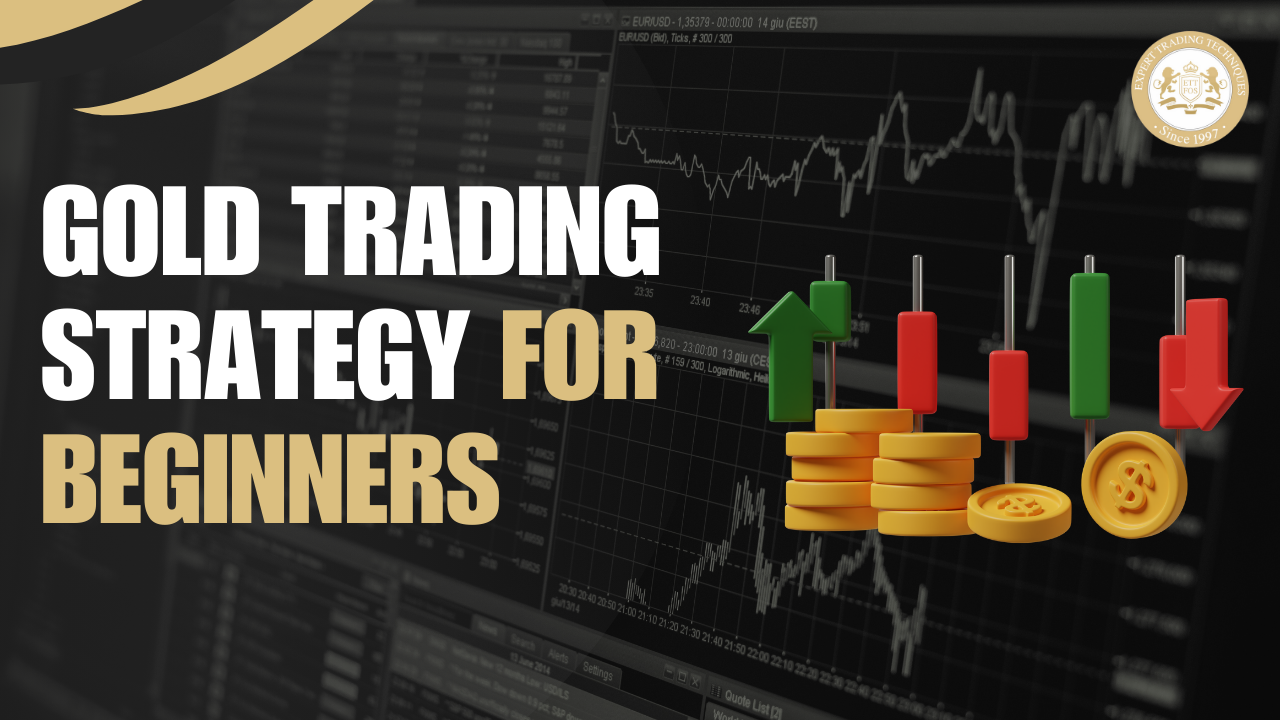
Gold has been a valuable asset for thousands of years, admired for its beauty and rarity. From ancient civilizations to modern financial markets, gold has always been a symbol of wealth and a trusted form of investment. Today, trading gold remains a key component in financial markets, attracting both seasoned investors and newcomers alike.
If you’re new to gold trading, the world of strategies and market movements might seem overwhelming. But don’t worry, this guide is here to simplify things. We’ll break down the basics of gold trading and explore various strategies you can use, from trend-following to technical analysis.
Our goal is to empower you with a solid understanding of how gold trading works and equip you with practical strategies to start trading confidently. By the end of this article, you’ll have a clearer idea of how to approach gold trading and make informed decisions that align with your financial goals.
Also Read: What Is Crypto Mining

Gold trading involves buying and selling gold with the goal of making a profit. It’s a popular way to invest because gold often retains its value well, even during economic downturns. When people talk about gold trading, they usually mean trading gold on financial markets. This can include buying physical gold, like gold bars or coins, or trading gold-related financial products such as futures contracts or gold exchange-traded funds (ETFs).
There are two main ways to trade gold. One is physical gold trading. This means buying actual gold, storing it, and selling it when you think the price has gone up. It requires dealing with storage and security but gives you tangible assets. Second is, Paper Gold Trading. This involves trading financial products that are linked to gold prices, such as gold futures or ETFs. It’s more about tracking the price of gold without actually holding it.
Gold trading can be influenced by various factors, including economic data, geopolitical events, and market trends. Traders use these factors to make decisions about when to buy or sell gold. For example, if there’s political instability, people might buy gold as a safe haven, which can drive up the price.
Also Read: How to Create a Winning Forex Trading Plan
Gold plays a key role in financial markets for several reasons. First, it’s seen as a “safe haven” asset. When other investments like stocks or bonds are struggling, investors often turn to gold. They do this because gold tends to hold its value well, even when the economy is unstable.
Second, gold is used as a hedge against inflation. When prices rise and money loses its purchasing power, gold usually remains valuable. This is because gold is a tangible asset with a long history of maintaining value over time.
Third, gold is also a popular way to diversify investment portfolios. By adding gold to their investments, people can spread out their risk. If one part of their portfolio isn’t performing well, gold might still do okay, helping to balance things out.
Finally, central banks and governments hold large reserves of gold as part of their financial strategy. These reserves can back up their currencies and provide economic stability. So, gold is not just a commodity for traders, it’s a crucial part of the global financial system.
Also Read: Crypto Mining Vs Crypto Trading
A gold trading strategy is a plan that helps you decide when to buy or sell gold to make a profit. It’s a set of rules or methods you follow based on how you think gold prices will move. The core idea behind a gold trading strategy is to predict price changes and act on those predictions. For example, you might buy gold if you expect the price to go up and sell it if you think it will drop.
Different strategies can be used depending on your goals and how much time you want to spend on trading. Some strategies focus on short-term moves, where traders buy and sell gold within a single day to catch quick price swings. Others are longer-term, looking at broader trends and holding onto gold for weeks or even months. A good strategy includes deciding on entry and exit points, when you’ll buy and when you’ll sell. It also involves managing risks, like setting limits to avoid losing too much money if things don’t go as planned.
Also Read: Common Mistakes In Intraday Crypto Trading

When it comes to trading gold, having a few solid strategies can make a big difference. Here are some essential ones that work for traders at all levels:
Also Read: What is Swing Trading in Crypto
There is no trading strategy as such that can be described as the best for trading gold. One strategy might work incredibly well for trader A, but poorly for trader B. It is recommended that start by figuring out what you want to achieve. Are you looking to make quick profits with short-term trades, or are you interested in long-term investments?
Think about how much time you can dedicate to trading. If you can only spend a few minutes a day, a strategy that involves quick trades, like day trading or swing trading, might be appropriate. If you can spend more time analyzing the market, strategies like technical analysis or fundamental analysis might be a good fit. No strategy is perfect from the start. Try out a few strategies in a demo account or with small trades to see what works best for you.
Also Read: What Is Commodity Trading

In gold trading, having the right tools to analyze price movements can make a big difference. Trading Indicators help traders understand trends, identify potential entry and exit points, and manage risks. By using these tools effectively, you can gain a clearer picture of market conditions and make more informed decisions. Here are some of the best indicators to consider:
This indicator smooths out price data over a set period, like 50 or 200 days. It helps you see the overall trend. For instance, if the price is above the moving average, it might indicate an uptrend, while being below could suggest a downtrend.
RSI measures how fast and how much the price of gold has moved recently. It ranges from 0 to 100 and helps identify whether gold is overbought or oversold. A reading above 70 might mean gold is overbought, while below 30 could mean it’s oversold.
This indicator shows the relationship between two moving averages of gold’s price. It helps identify potential buy or sell signals by looking at the MACD line and the signal line, as well as any crossovers.
These bands consist of a middle band (a moving average) and two outer bands that adjust based on price volatility. When the price touches the upper band, it might be a sign that gold is overbought. When it hits the lower band, it might be oversold.
This tool helps identify potential support and resistance levels based on the Fibonacci sequence. Traders use these levels to predict where the price might bounce or reverse.
Tracking trading volume helps confirm the strength of a price move. For example, a price increase with high volume can indicate strong buying interest, while an increase with low volume might be less reliable.
Also Read: What Is Swing Trading in Forex

Fundamental analysis in gold trading is all about understanding the factors that drive gold prices. Unlike technical analysis, which focuses on price charts and patterns, fundamental analysis looks at broader economic and financial influences. By keeping an eye on these factors and understanding their potential impact on gold, traders can make more informed decisions about when to buy or sell. Key factors include:
Let’s look at a real-world example of a gold trading strategy to see how it works in practice. Imagine you’re using a simple trend-following strategy. You start by looking at a gold price chart and notice that gold has been rising steadily for the past few months. To confirm the trend, you check the 50-day moving average and see that the price is consistently above this average, which suggests an uptrend.
Based on this, you decide to buy gold. Your plan includes setting a stop-loss order to limit potential losses if the price suddenly drops. You also set a target price where you plan to sell for a profit. A few weeks later, gold’s price continues to rise, reaching your target. You sell your gold position, locking in the profit. However, if the price had fallen below your stop-loss level, you would have sold to minimize your losses.
This strategy works by following the trend and using clear rules for when to enter and exit trades. It’s a practical way to trade gold based on observed patterns and predefined rules, making it easier to stick to a plan and manage risks.
Also Read: Techniques to Manage Emotions in Forex Trading
In summary, mastering gold trading strategies is essential for improving your trading success. Whether you’re using trend-following, fundamental analysis, or technical indicators, each strategy provides unique insights into gold price movements and helps you make more informed decisions. Applying these techniques thoughtfully allows you to manage risks effectively and capitalize on market opportunities.
For those looking to deepen their knowledge and improve their trading skills, consider exploring ETTFOS. Their Core Masterclass offers comprehensive training and resources to help you master advanced trading techniques. This can be a valuable addition to your trading toolkit. Start applying these strategies today and see how they can enhance your trading performance.
For beginners, a trend-following strategy is often the best choice. It’s straightforward and involves buying gold when prices are rising and selling when they’re falling, based on clear, observable trends.
Technical analysis for gold trading involves using charts and indicators like moving averages and RSI to identify price patterns and trends. This helps you make informed decisions about when to buy or sell based on historical price data.
Gold trading carries risks such as price volatility and market unpredictability. Prices can fluctuate widely due to economic events or geopolitical issues, potentially leading to significant losses if not managed carefully.
You should review your gold trading strategies regularly, ideally every few weeks or after major market events. This helps ensure your approach remains aligned with current market conditions and your trading goals.